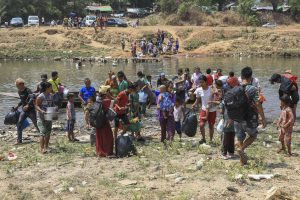Several thousand people from Myanmar’s Kayin (Karen) State have crossed the border into Thailand to take refuge from escalating battles between Myanmar junta forces and ethnic Karen troops, according to Thai officials. Foreign Affairs Minister Parnpree Bahiddha-Nukara said yesterday that the number of Myanmar refugees in Mae Sot had risen to around 3,000, as fighting flared across the border around the Myanmar city of Myawaddy.
On April 10, the Karen National Liberation Army (KNLA), the armed wing of the Karen National Union, said that it had captured the last Myanmar military outpost in Myawaddy, along with allied People’s Defense Forces. However, the junta forces in the area did not surrender and subsequently retreated to the customs compound at the second of the two bridges linking the two countries across the Moei River, where they continue to hold out for reinforcements.
Thai officials reported that people started crossing the border on Friday, when the KNLA launched an attack against the Myanmar troops close to the bridge. These escalated on Saturday, when the military reportedly used artillery, fighter jets, and helicopter gunships to attack KNLA positions, and resistance forces used 40mm machine guns and dropped 20 bombs from drones, prompting hundreds of people to flee across the Moei River.
In a statement yesterday, the National Unity Government claimed that the junta had launched “various forms of targeted attacks, including artillery attacks and airstrikes on the public buildings and properties of civilians.”
As The Associated Press reported, “Footage from the Thai border showed Thai soldiers maintaining guard near the bridge with sounds of explosions and gunshots in the background. People with children waded across the river with their belongings and were received by Thai officials on the river bank. Several are seen taking shelter in buildings along the river bank on the Myanmar side.”
While the fighting has since subsided, the battle is likely to continue in the coming days. Late last week, the Myanmar military council launched Operation Aung Zeya, named after the founder of Myanmar’s Konbaung Dynasty, in a bid to retake Myawaddy, the largest of the country’s six crossings with Thailand, and stave off another humiliating defeat. The Irrawaddy reported on Friday that Myanmar military units are attempting to approach Myawaddy via Kawkareik, a town 43 kilometers to the west.
In a statement yesterday, the National Unity Government thanked Thailand for providing shelter and assistance to refugees, but predicted further displacement. “As the junta has been escalating the indiscriminatory targeted attacks on civilians, we expect that the number of people fleeing from those areas might rise in the coming days,” it added.
The outbreak of fighting around Myawaddy has prompted Thailand to bolster its border defenses, enhancing its control over those crossing the two bridges linking Myawaddy and Mae Sot, which have remained open despite the fighting. According to the Bangkok Post, a stray bullet from the fighting in Myawaddy hit a house on the Thai side of the border during Saturday’s clashes.
Thailand’s Foreign Ministry said it was closely monitoring the situation and “will continue to provide further humanitarian assistance if necessary and will do our utmost to ensure the situation along the Thai-Myanmar border area returns to normalcy,” ministry spokesperson Nikorndej Balankura said in a statement. Foreign Minister Parnpree has previously announced that the country had the capacity to handle up to 100,000 refugees in and around Mae Sot.
In a post on X (formerly Twitter) on Saturday evening, Prime Minister Srettha Thavisin said that his government was “ready to protect our borders and the safety of our people.” He announced that he would travel to Mae Sot tomorrow to get a first-hand look at the fast-moving situation.

































